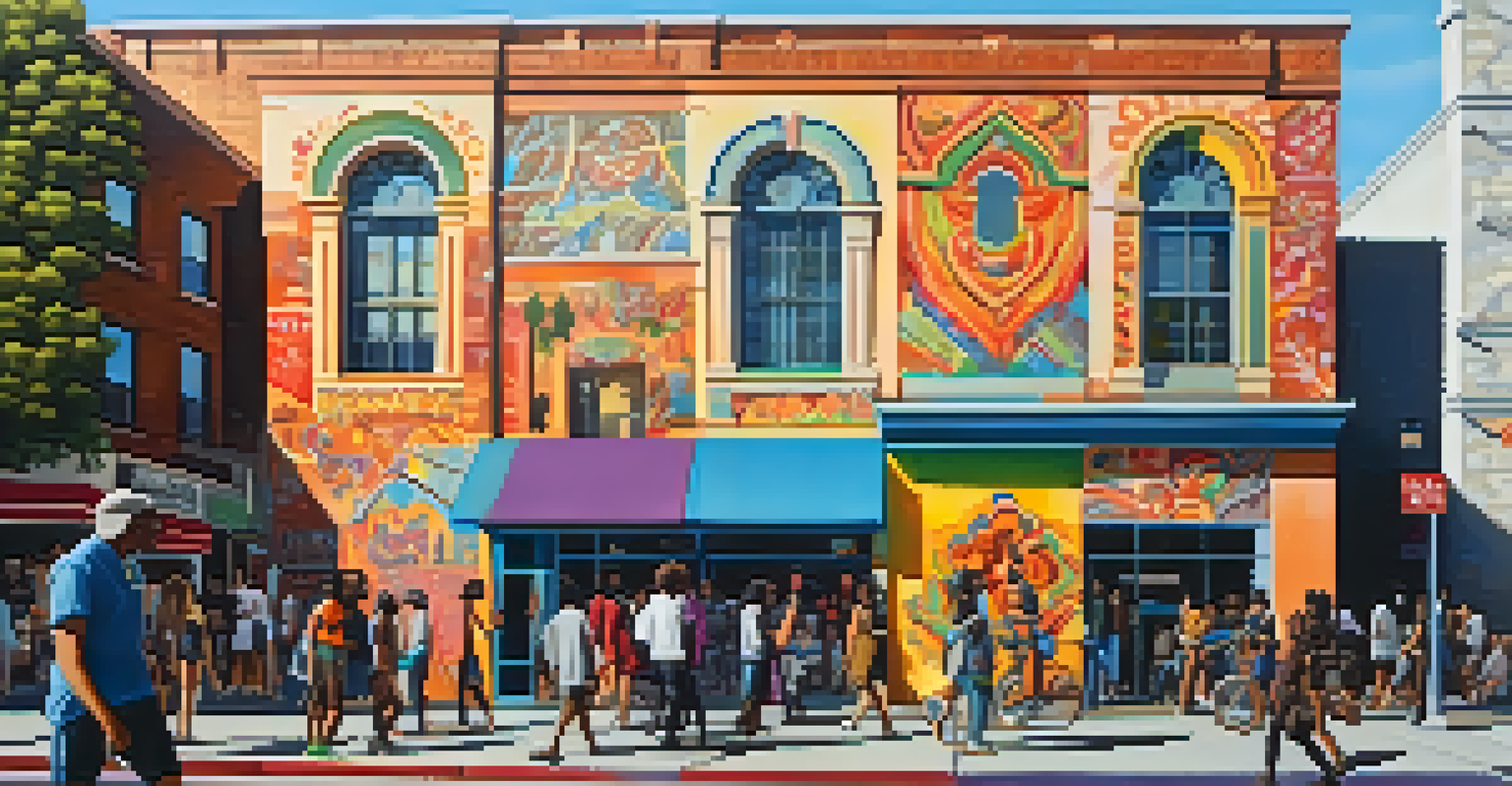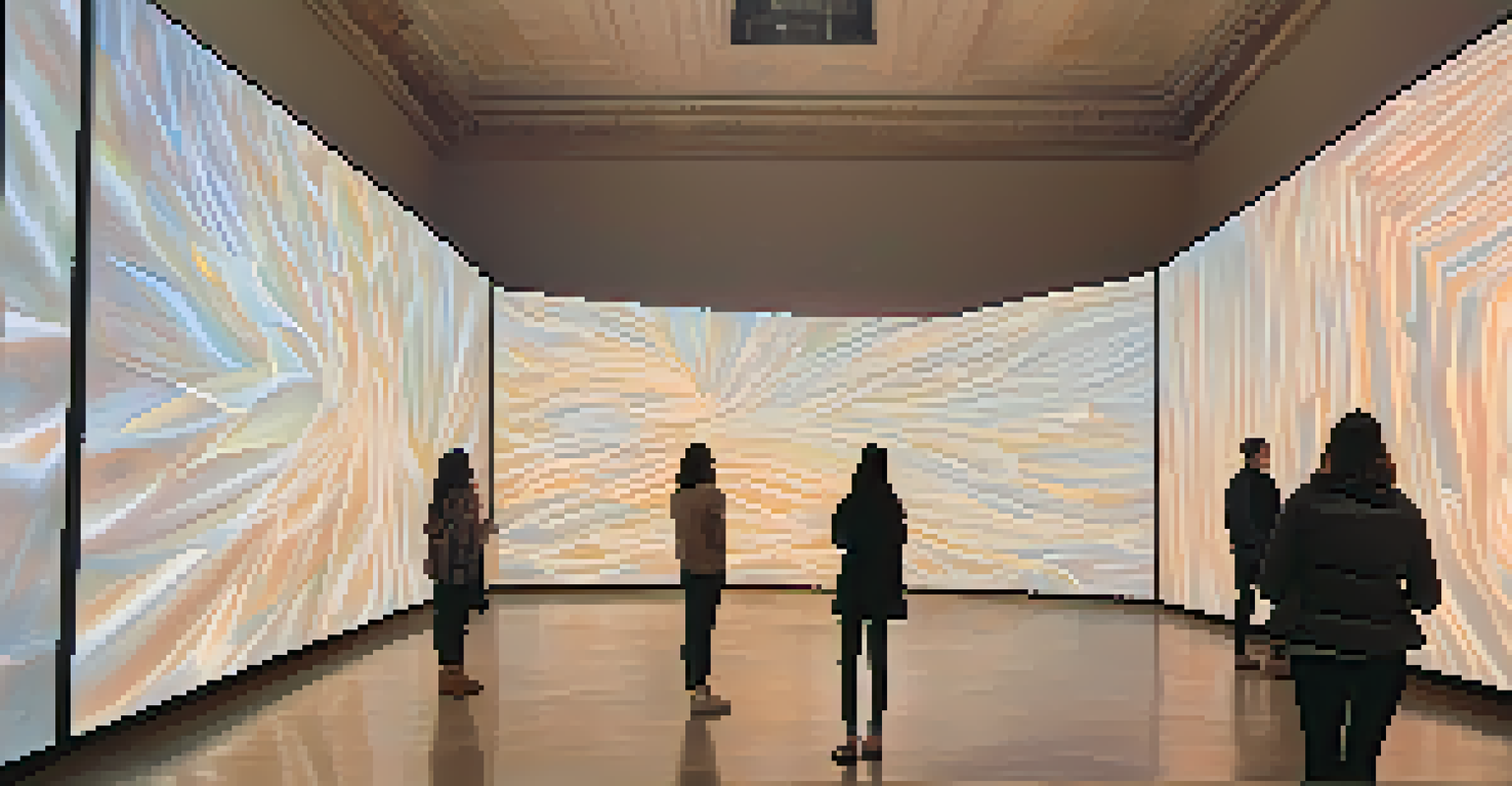Art Movements Originating from California's Creative Scene

The Birth of the California Impressionism Movement
California Impressionism emerged in the late 19th century, largely influenced by the natural beauty of the state's landscapes. Artists like Guy Rose and William Wendt were drawn to the vibrant light and varied scenery, leading to a distinctive approach that emphasized color and light. They painted en plein air, capturing the essence of California's coastal views and rolling hills.
Art is the most beautiful of all lies.
This movement marked a departure from the more rigid techniques of European Impressionism, as Californian artists sought to express their own experiences and surroundings. The accessibility of the state's landscapes allowed artists to explore new themes and techniques, leading to a rich tapestry of work that reflected both the place and time. The influence of this movement can still be seen in contemporary art, as many artists continue to draw inspiration from California's diverse environments.
Today, California Impressionism is celebrated in various museums and galleries across the state, showcasing the works of these pioneering artists. Their legacy serves as a reminder of how the environment can shape artistic expression, encouraging future generations to explore and innovate within their own contexts.
The Rise of the California Funk Art Movement
Emerging in the 1960s, California Funk Art was a reaction against the seriousness of the mainstream art world. Artists like Robert Arneson and Peter Vandenberg used humor and irony to challenge traditional aesthetics, creating pieces that were both playful and provocative. This movement embraced a variety of mediums, including ceramics, sculpture, and mixed media, allowing for a broad range of expression.

Funk Art often incorporated everyday materials and objects, elevating the mundane to the level of fine art. These artists saw beauty in the overlooked and the absurd, pushing boundaries and redefining what art could be. The playful nature of this movement encouraged viewers to engage with art in a more personal and interactive way, inviting them to question societal norms.
California's Art Movements Evolve
California has birthed various art movements, each reflecting the state's cultural diversity and innovative spirit.
Today, Funk Art remains influential, inspiring artists to explore unconventional methods and themes. Its legacy lives on in contemporary practices that prioritize humor and relatability, showing that art can be both meaningful and fun.
The Impact of the California Beat Generation on Art
The Beat Generation of the 1950s and 60s brought a wave of cultural change that extended beyond literature and into the visual arts. Influential figures like Allen Ginsberg and Jack Kerouac challenged societal norms, encouraging artists to explore themes of spontaneity and existentialism. This movement fostered a spirit of experimentation, giving rise to new artistic expressions that reflected the counterculture of the time.
The best artist has no conception that a marble block does not contain within it the figure that will emerge from it.
Artists associated with the Beat Generation, such as Wallace Berman and Jay DeFeo, often blended poetry, collage, and painting to create works that were deeply personal and reflective. Their art was characterized by a raw, unfiltered approach, capturing the essence of their experiences and emotions. This fusion of art and literature helped create a vibrant, interdisciplinary scene that resonated with many.
The Beat Generation's influence on California's art scene can still be felt today, as contemporary artists continue to embrace the ideals of freedom and self-expression. By breaking away from traditional constraints, these artists pave the way for new movements and styles, ensuring that the spirit of the Beats lives on.
The Evolution of the Light and Space Movement
The Light and Space Movement emerged in the late 1960s, primarily in Southern California, focusing on the perception of light and its interaction with space. Artists like James Turrell and Robert Irwin created immersive installations that challenged viewers' perceptions and invited them to experience art in a new way. This movement emphasized the importance of the viewer's experience, making them an active participant in the artwork.
By manipulating light and materials, artists were able to create environments that shifted and changed, resulting in a dynamic relationship between the artwork and its surroundings. This approach not only transformed the way art was created but also how it was experienced, encouraging audiences to engage with their environment more thoughtfully. The movement's emphasis on perception and environment continues to influence contemporary art practices.
Influence of Nature on Art
The state's stunning landscapes and environments have profoundly shaped artistic expressions from California Impressionism to contemporary practices.
Today, the Light and Space Movement is celebrated for its innovative approach, with many artists exploring similar themes in their work. Its legacy encourages a deeper understanding of how art can alter our perceptions and invite us to see the world through a different lens.
Exploring the California Street Art Scene
California's street art scene has flourished over the years, giving voice to artists outside the traditional gallery system. This vibrant expression often reflects the diverse cultures and communities within the state, with artists using public spaces as their canvas. From murals to graffiti, these artworks serve as powerful messages, addressing social issues and celebrating local identity.
With cities like Los Angeles and San Francisco at the forefront, street art has gained recognition as a legitimate art form. Artists such as Shepard Fairey and Banksy have helped elevate the genre, blurring the lines between street art and fine art. The accessibility of street art allows for a more democratic approach to art, making it available to everyone and fostering community engagement.
Today, California's street art scene continues to thrive, with festivals and events celebrating this dynamic form of expression. As artists push boundaries and challenge conventions, they remind us that art can exist beyond the confines of traditional spaces, making a lasting impact on society.
The Influence of California's Digital Art Movement
California has long been a hub for technological innovation, and this has significantly influenced the digital art movement. With the rise of Silicon Valley, artists began to experiment with new media, incorporating technology into their work. This movement encompasses a wide range of practices, including digital painting, video art, and interactive installations, pushing the boundaries of traditional art forms.
Digital artists like Casey Reas and Jenny Holzer have utilized technology to create thought-provoking pieces that engage audiences in unique ways. The ability to manipulate images and sound has opened up new avenues for storytelling and self-expression, allowing artists to connect with viewers on multiple levels. This movement reflects the ever-evolving nature of art in response to technological advancements.
Art as a Reflection of Society
Art movements in California often address social issues and encourage community engagement, showcasing the power of creativity in shaping culture.
As digital art continues to gain popularity, California remains at the forefront of this innovative landscape. The fusion of art and technology inspires a new generation of creators, encouraging them to explore the limitless possibilities of digital mediums.
The Legacy of the California Arts and Crafts Movement
The California Arts and Crafts Movement, which gained momentum in the early 20th century, celebrated handmade craftsmanship and the beauty of natural materials. Influential figures like Bernard Maybeck and Julia Morgan emphasized simplicity and functionality in their designs, blending aesthetics with practicality. This movement sought to counter the industrialization of art and design, promoting a return to artisanal skills.
Through architecture, furniture design, and decorative arts, the California Arts and Crafts Movement aimed to create harmonious living spaces that reflected the surrounding environment. The movement's principles emphasized the importance of craftsmanship, sustainability, and a connection to nature, values that resonate strongly in contemporary design today. The legacy of this movement can be seen in the continued appreciation for handmade and locally-sourced materials.

Today, the California Arts and Crafts Movement is celebrated for its influence on American design and architecture. Its emphasis on craftsmanship and natural beauty continues to inspire artists and designers, reminding us of the importance of preserving these values in a rapidly changing world.
Conclusion: The Diverse Tapestry of California's Art Scene
California's art movements reflect the state's rich cultural diversity and innovative spirit. From Impressionism to digital art, each movement has contributed to a vibrant tapestry that continues to evolve. The artistic expressions emerging from California not only showcase the unique experiences of its artists but also inspire future generations to explore and push boundaries.
As artists draw inspiration from their surroundings, California remains a fertile ground for creativity and experimentation. The state's ability to embrace change and celebrate diversity ensures that its art scene will continue to flourish. Each movement tells a story, inviting us to engage with the world through the lens of art.
In conclusion, the art movements originating from California are a testament to the power of creativity in shaping culture and identity. As we celebrate this dynamic landscape, we are reminded of the importance of artistic expression in fostering understanding and connection among communities.